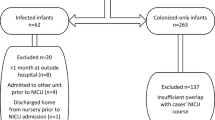Abstract
Objective:
To assess the epidemiology of methicillin-susceptible Staphylococcus aureus (MSSA) and methicillin-resistant S. aureus (MRSA) infections in a neonatal intensive care unit (NICU).
Study Design:
A retrospective chart review was conducted from 2000–2007; demographic and clinical characteristics of infected infants and crude mortality were assessed.
Results:
During the study period, there were 123 infections caused by MSSA and 49 infections caused by MRSA. Although the types of infections caused by MSSA and MRSA were similar, infants with MRSA infections were younger at clinical presentation than infants with MSSA infections (P=0.03). The overall rate of S. aureus infections was approximately 15–30 per 1000 patient-admissions. The rate of bacteremia and skin and soft tissue infections remained stable over time. Among extremely low birth weight infants (birth weight <1000 g), 4.8 and 1.8% developed an infection caused by MSSA or MRSA, respectively. Infections occurred in a bimodal distribution of birth weight; 53% of infections occurred in extremely low birth weight infants and 27% occurred among term infants birth weight ⩾2500 g, many of whom underwent surgical procedures.
Conclusions:
MSSA and MRSA remain significant pathogens in the NICU, particularly for extremely premature infants and term infants undergoing surgery. Further work should investigate infection control strategies that effectively target the highest risk groups and determine if vertical transmission of MRSA is responsible for the younger age at presentation of infection.
This is a preview of subscription content, access via your institution
Access options
Subscribe to this journal
Receive 12 print issues and online access
$259.00 per year
only $21.58 per issue
Buy this article
- Purchase on Springer Link
- Instant access to full article PDF
Prices may be subject to local taxes which are calculated during checkout


Similar content being viewed by others
References
Stoll BJ, Hansen N, Fanaroff AA, Wright LL, Carlo WA, Ehrenkranz RA et al. Late-onset sepsis in very low birth weight neonates: the experience of the NICHD Neonatal Research Network. Pediatrics 2002; 110: 285–291.
Kuint J, Barzilai A, Regev-Yochay G, Rubinstein E, Keller N, Maayan-Metzger A . Comparison of community-acquired methicillin-resistant Staphylococcus aureus bacteremia to other staphylococcal species in a neonatal intensive care unit. Eur J Pediatr 2007; 166: 319–325.
Davis SL, Perri MB, Donabedian SM, Manierski C, Singh A, Vager D et al. Epidemiology and outcomes of community-associated methicillin-resistant Staphylococcus aureus infection. J Clin Microbiol 2007; 45: 1705–1711.
Saiman L, Cronquist A, Wu F, Zhou J, Rubenstein D, Eisner W et al. An outbreak of methicillin-resistant Staphylococcus aureus in a neonatal intensive care unit. Infect Control Hosp Epidemiol 2003; 24: 317–321.
Duchon J, Graham III PL, Della-Latta P, Whittier S, Carp D, Bateman D et al. Epidemiology of enterococci in a neonatal intensive care unit. Infect Control Hosp Epidemiol 2008; 29: 374–376.
National Committee for Clinical Laboratory Standards. Performance Standard for Antimicrobial Disk Susceptibility Tests- approved standard 1993. NCCLS document M2A5: Villanova PA.
National Committee for Clinical Laboratory Standards. Methods for Dilution Antimicrobial Susceptibility Testing for Bacteria that Grow Aerobically-Approved Standard 1993. NCCLS document M7A3: Villanova PA.
R Development Core Team. R: A Language and Environment for Statistical Computing. R Foundation for Statistical Computing, Vienna, Austria, http://www.R-project.org 2008.
Chen KT, Huard RC, Della-Latta P, Saiman L . Prevalence of methicillin-sensitive and methicillin-resistant Staphylococcus aureus in pregnant women. Obstet Gynecol 2006; 108: 482–487.
Chen KT, Campbell H, Borrell LN, Huard RC, Saiman L, Della-Latta P . Predictors and outcomes for pregnant women with vaginal-rectal carriage of community-associated methicillin-resistant Staphylococcus aureus. Am J Perinatol 2007; 24: 235–240.
Saiman L, O'Keefe M, Graham III PL, Wu F, Said-Salim B, Kreiswirth B et al. Hospital transmission of community-acquired methicillin-resistant Staphylococcus aureus among postpartum women. Clin Infect Dis 2003; 37: 1313–1319.
Abramson MA, Sexton DJ . Nosocomial methicillin-resistant and methicillin-susceptible Staphylococcus aureus primary bacteremia: at what costs? Infect Control Hosp Epidemiol 1999; 20: 408–411.
Chaix C, Durand-Zaleski I, Alberti C, Brun-Buisson C . Control of endemic methicillin-resistant Staphylococcus aureus: a cost-benefit analysis in an intensive care unit. JAMA 1999; 282: 1745–1751.
Davenport M, Doig CM . Wound infection in pediatric surgery: a study in 1094 neonates. J Pediatr Surg 1993; 28: 26–30.
Korakaki E, Aligizakis A, Manoura A, Hatzidaki E, Saitakis E, Anatoliotaki M et al. Methicillin-resistant Staphylococcus aureus osteomyelitis and septic arthritis in neonates: diagnosis and management. Jpn J Infect Dis 2007; 60: 129–131.
Friedland IR, du Plessis J, Cilliers A . Cardiac complications in children with Staphylococcus aureus bacteremia. J Pediatr 1995; 127: 746–748.
Carey AJ, Graham III PL, Hyman S, Carp D, Wu F, Della-Latta P et al. Molecular epidemiology of methicillin resistant Staphylococcus aureus (MRSA) in a level III-IV neonatal intensive care unit (NICU) (Abstract 2857.189). In: Pediatric Academic Society's Annual Meeting. San Francisco, CA, 2006.
McAdams RM, Ellis MW, Trevino S, Rajnik M . Spread of methicillin-resistant Staphylococcus aureus USA300 in a neonatal intensive care unit. Pediatr Int 2008; 50: 810–815.
Jahamy H, Ganga R, Al Raiy B, Shemes S, Nagappan V, Sharma M et al. Staphylococcus aureus skin/soft-tissue infections: the impact of SCCmec type and Panton-Valentine leukocidin. Scand J Infect Dis 2008; 40: 601–606.
Saiman L . Preventing infections in the neonatal intensive care unit. In: Wenzel R, eds Prevention and Control of Nosocomial Infections. 4th edn Lippincott, Williams & Wilkins: Philadelphia, PA, 2003; 342–368.
Guyot A, Layer G . MRSA—‘bug-bear’ of a surgical practice: reducing the incidence of MRSA surgical site infections. Ann R Coll Surg Engl 2006; 88: 222–223.
Acknowledgements
Ms Shing Lee and Mr Jimmy K Duong of the Biostatistics Consulting Services and the Irving Institute for Clinical and Translational Research at Columbia University Medical Center carried out a statistical consult. We appreciate the helpful comments of Dr John Lorenz. This study was unfunded.
Author information
Authors and Affiliations
Corresponding author
Rights and permissions
About this article
Cite this article
Carey, A., Duchon, J., Della-Latta, P. et al. The epidemiology of methicillin-susceptible and methicillin-resistant Staphylococcus aureus in a neonatal intensive care unit, 2000–2007. J Perinatol 30, 135–139 (2010). https://doi.org/10.1038/jp.2009.119
Received:
Revised:
Accepted:
Published:
Issue Date:
DOI: https://doi.org/10.1038/jp.2009.119



